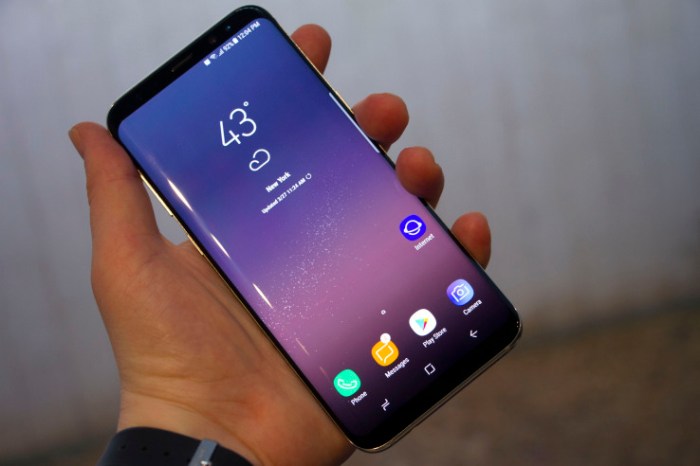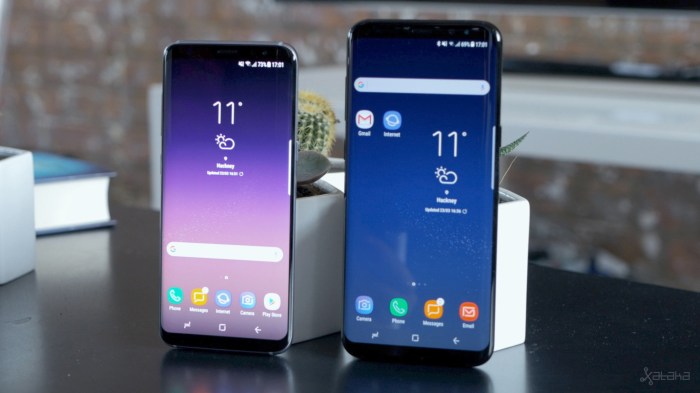Samsung Galaxy S8 Edge Specification Overview
Samsung Galaxy S8 Edge: A Deep Dive into Specifications: Samsung Galaxy S8 Edge Specification
Samsung galaxy s8 edge specification – The Samsung Galaxy S8 Edge, released in 2017, represented a significant leap forward in smartphone design and technology. Its distinctive curved display and powerful internal components made it a flagship contender. This article delves into the key specifications and features of this iconic device.
Display and Design, Samsung galaxy s8 edge specification

Source: gearopen.com
The Galaxy S8 Edge boasted a stunning 5.8-inch Super AMOLED display with a resolution of 1440 x 2960 pixels. This resulted in a sharp, vibrant, and incredibly detailed viewing experience. The phone measured approximately 148.9 x 68.1 x 8.0 mm and weighed around 155 grams, making it relatively compact and comfortable to hold despite its large screen.
Compared to other flagship phones of its time, the S8 Edge stood out with its distinctive curved screen design. This design element was a key differentiator, setting it apart from the more traditional flat-screen designs of competitors.
| Manufacturer | Model | Screen Size (inches) | Design Features |
|---|---|---|---|
| Samsung | Galaxy S8 Edge | 5.8 | Curved display, glass back, metal frame |
| Apple | iPhone X | 5.8 | Edge-to-edge display, stainless steel frame, glass back |
| Pixel 2 XL | 6.0 | Large display, glass back, metal frame | |
| LG | LG G6 | 5.7 | 18:9 aspect ratio, glass back, metal frame |
The S8 Edge’s construction utilized premium materials, including Gorilla Glass 5 on both the front and back, and a sturdy aluminum frame. This combination contributed to a high-end feel and robust build quality.
Performance and Hardware
Powering the Galaxy S8 Edge was either a Qualcomm Snapdragon 835 or Samsung Exynos 8895 octa-core processor, depending on the region. These processors offered clock speeds up to 2.35 GHz, ensuring smooth and responsive performance. RAM options included 4GB.
Compared to its predecessor and a contemporary competitor, the S8 Edge showcased significant performance improvements:
- Galaxy S8 Edge vs. Galaxy S7 Edge: The S8 Edge featured a more powerful processor, resulting in faster processing speeds and improved graphics performance. It also incorporated the latest advancements in AI processing.
- Galaxy S8 Edge vs. iPhone X: Both phones offered comparable performance, with minor variations depending on specific benchmarks and tasks. The iPhone X generally excelled in certain graphics-intensive games, while the S8 Edge often performed better in multi-tasking scenarios.
Internal storage options were typically 64GB or 128GB, and the phone also included a microSD card slot for expandable storage up to 256GB, providing flexibility for users with large media libraries.
Camera Features

Source: techienize.com
The Galaxy S8 Edge featured a dual-camera system. The rear camera boasted a 12MP sensor with a bright f/1.7 aperture, offering excellent low-light capabilities and fast autofocus. The front-facing camera was an 8MP sensor with an f/1.7 aperture, ideal for selfies and video calls. The camera included features like HDR, optical image stabilization (OIS), and various shooting modes.
Image processing was advanced, leveraging Samsung’s image processing algorithms to produce vibrant and detailed photos. A comparison with the Google Pixel 2, known for its exceptional camera performance, reveals some key differences:
| Feature | Samsung Galaxy S8 Edge | Google Pixel 2 |
|---|---|---|
| Rear Camera Megapixels | 12MP | 12.2MP |
| Low-Light Performance | Good, but Pixel 2 generally excelled | Excellent, renowned for its low-light capabilities |
| Image Quality | High quality, vibrant colors | High quality, known for its detail and natural color reproduction |
| Unique Features | Dual aperture | HDR+ |
A unique feature of the S8 Edge’s camera was its dual aperture, allowing for automatic adjustment between f/1.7 and f/2.4 depending on lighting conditions. This optimized image capture in both bright and low-light situations.
The Samsung Galaxy S8 Edge boasted impressive specs for its time, including a stunning curved display and powerful processor. To understand its evolution, it’s helpful to compare it to its predecessor, by checking out the detailed specifications of the samsung galaxy s7 edge specification. Seeing the differences highlights the advancements Samsung made in camera technology and overall performance in the S8 Edge model.
Battery and Connectivity
The Galaxy S8 Edge housed a 3000mAh battery. Battery life varied depending on usage patterns, but generally provided a full day of use under moderate usage conditions. Heavy users might require charging before the end of the day.
Connectivity options included Wi-Fi 802.11 a/b/g/n/ac, Bluetooth 5.0, NFC, and a USB Type-C port for fast charging. Compared to competitors:
- Battery Life: While the 3000mAh battery was competitive for its time, some devices offered slightly longer battery life.
- Charging Speed: The S8 Edge supported fast charging, but newer technologies offered even faster charging speeds.
Software and Features
The Samsung Galaxy S8 Edge launched with Android 7.0 Nougat and Samsung’s custom user interface, Samsung Experience. This overlay added several unique features and customizations to the Android operating system.
Five of the most notable software features included:
- Always-on Display
- Edge Screen features (apps, shortcuts, news feeds)
- Bixby (Samsung’s virtual assistant)
- Samsung DeX (desktop experience mode)
- Secure Folder (encrypted space for private data)
Security features at launch included a fingerprint sensor, iris scanner, and facial recognition, offering multiple layers of authentication to protect user data.
Illustrative Description of the Device

Source: blogs.es
Imagine holding a sleek, smooth device. Its curved edges gently caress your palm, the glass back cool and reflective. The overall impression is one of sophisticated elegance. The phone’s frame is a subtle, almost imperceptible metal band that holds the glass together seamlessly. The curved display extends almost to the edges, creating a visually stunning and immersive experience.
The screen itself is a deep, rich black when off, and explodes with vibrant color when activated. Available launch colors included Midnight Black, Orchid Gray, Arctic Silver, and Coral Blue, each offering a unique aesthetic.
The curved screen wasn’t just a design flourish; it integrated seamlessly with the phone’s functionality. The Edge Screen provided quick access to frequently used apps, contacts, and news feeds. Swiping along the curved edge allowed for easy multitasking and quick access to information without interrupting the main display.
Common Queries
Is the Samsung Galaxy S8 Edge water resistant?
Yes, it has an IP68 rating, meaning it’s dustproof and water-resistant to a certain depth and duration.
Does the Samsung Galaxy S8 Edge support wireless charging?
Yes, it supports Qi wireless charging.
What type of expandable storage does the S8 Edge use?
It uses microSDXC cards for expandable storage.
What is the headphone jack situation on the S8 Edge?
The S8 Edge does not have a 3.5mm headphone jack; it uses USB-C headphones or a USB-C to 3.5mm adapter.





















